technical data LOTUS ELISE 2005 Owners Manual
[x] Cancel search | Manufacturer: LOTUS, Model Year: 2005, Model line: ELISE, Model: LOTUS ELISE 2005Pages: 205, PDF Size: 4.51 MB
Page 7 of 205
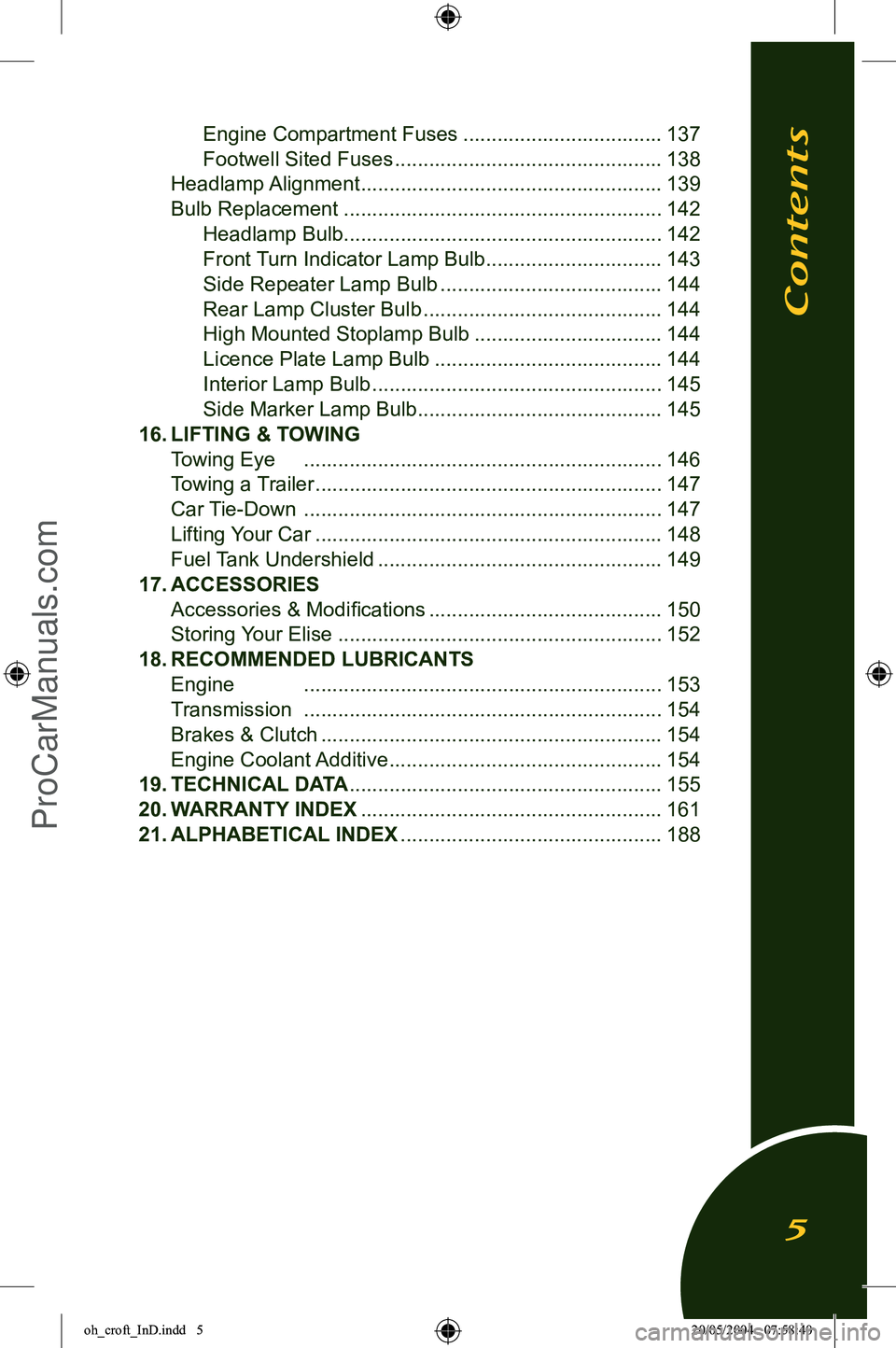
Engine Compartment Fuses ...................................137
Footwell Sited Fuses ...............................................
138
Headlamp Alignment .....................................................
139
Bulb Replacement ........................................................
142
Headlamp Bulb ........................................................
142
Front Turn Indicator Lamp Bulb ...............................
143
Side Repeater Lamp Bulb .......................................
144
Rear Lamp Cluster Bulb ..........................................
144
High Mounted Stoplamp Bulb .................................
144
Licence Plate Lamp Bulb ........................................
144
Interior Lamp Bulb ...................................................
145
Side Marker Lamp Bulb ...........................................
145
16. LIFTING & TOWING
Towing Eye ...............................................................146
Towing a Trailer .............................................................147
Car Tie-Down ...............................................................
147
Lifting Your Car .............................................................148
Fuel Tank Undershi
eld ..................................................149
17. A
CCESSORIES
Accessories & Modifications .........................................150
Storing Your Elise .........................................................
152
18. RECOMMENDED LUBRICANTS
Engine ...............................................................
153
Transmission ...............................................................
154
Br
akes & Clutch ............................................................154
Engine Coolant Additive ................................................
154
19. TECHNICAL DATA .......................................................155
20. WARRANTY INDEX .....................................................161
21. ALPHABETICAL INDEX ..............................................188
Contents
5
oh_croft_InD.indd 520/05/2004 07:58:40ProCarManuals.com
Page 110 of 205
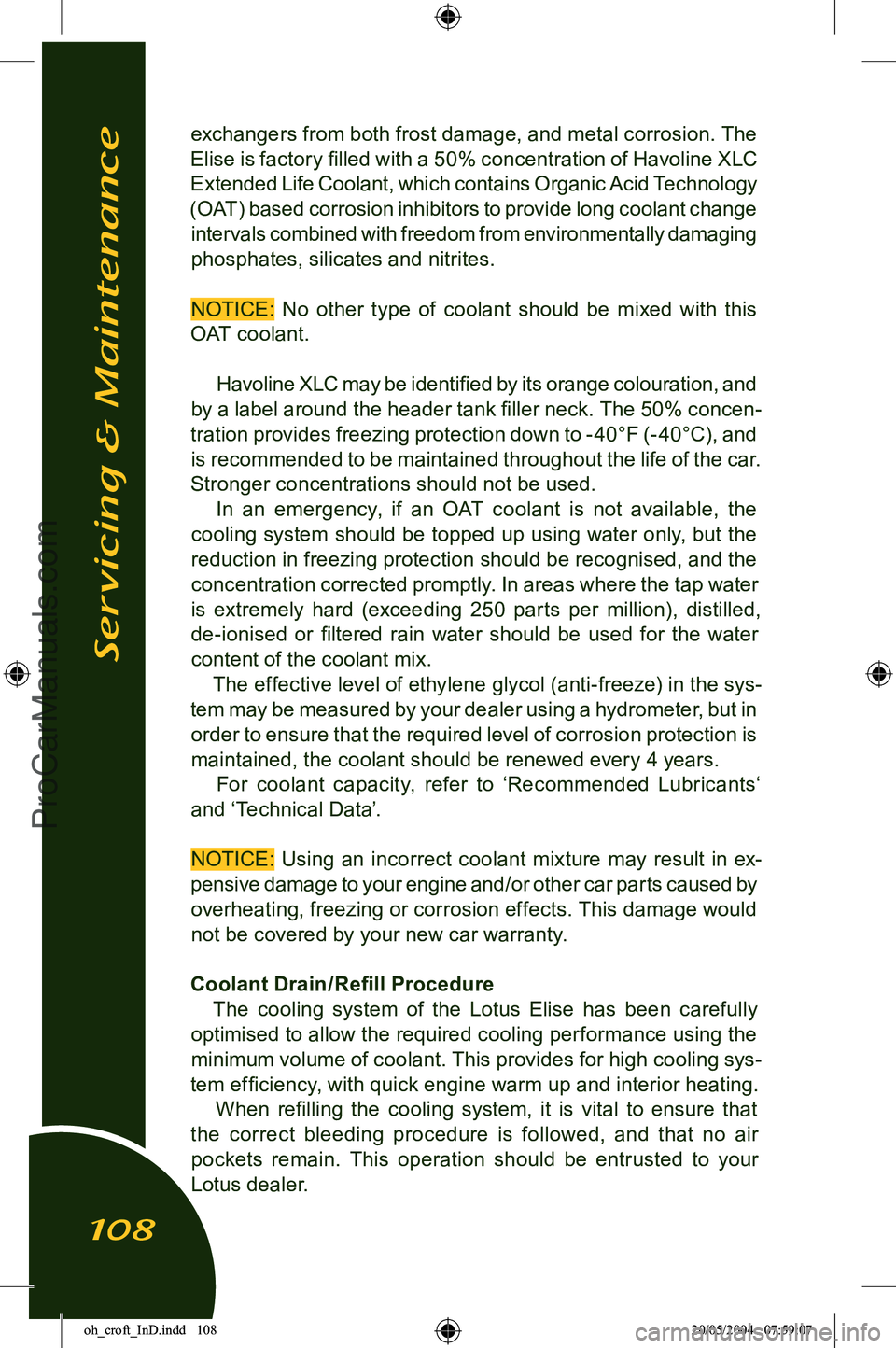
exchangers from both frost damage, and metal corrosion. The
Elise is factory filled with a 50% concentration of Havoline XLC
Extended Life Coolant, which contains Organic Acid Technology
(OAT) based corrosion inhibitors to provide long coolant change intervals combined with freedom from environmentally damaging phosphates, silicates and nitrites.
NOTICE: No other type of coolant should be mixed with this
OAT coolant.
Havoline XLC may be identified by its orange colouration, and
by a label around the header tank filler neck. The 50% concen
-
tration provides freezing protection down to - 40°F (- 40°C), and is recommended to be maintained throughout the life of the car.
Stronger concentrations should not be used. In an emergency, if an OAT coolant is not available, the
cooling system should be topped up using water only, but the reduction in freezing protection should be recognised, and the
concentration corrected promptly. In areas where the tap water is extremely hard (exceeding 250 parts per million), distilled, de-ionised or filtered rain water should be used for the water
content of the coolant mix. The effective level of ethylene glycol (anti-freeze) in the sys
-
tem may be measured by your dealer using a hydrometer, but in order to ensure that the required level of corrosion protection is
maintained, the coolant should be renewed every 4 years. For coolant capacity, refer to ‘Recommended Lubricants‘
and ‘Technical Data’.
NOTICE: Using an incorrect coolant mixture may result in ex
-
pensive damage to your engine and/or other car parts caused by overheating, freezing or corrosion effects. This damage would
not be covered by your new car warranty.
Coolant Drain /Refill Procedure The cooling system of the Lotus Elise has been carefully
optimised to allow the required cooling performance using the
minimum volume of coolant. This provides for high cooling sys
-
tem efficiency, with quick engine warm up and interior heating. When refilling the cooling system, it is vital to ensure that
the correct bleeding procedure is followed, and that no air pockets remain. This operation should be entrusted to your
Lotus dealer.
Servicing & Maintenance
108
oh_croft_InD.indd 10820/05/2004 07:59:07ProCarManuals.com
Page 117 of 205

TIRES AND WHEELS
TiresGlossary of Terms:Recommended inflation pressure: The cold tire inflation pressure which is recommended for this car and is speci
-
fied in the ‘Technical Data’ section of this handbook.
Cold tire inflation pressure: All tires must be cold, meaning
that the car has been stationary for a minimum of 3 hours, or has been driven less than 1 mile. Adjust pressures only
in ambient conditions.
Maximum inflation pressure: The maximum inflation pres
-
sure to which the tire should be subjected. For the Elise,
use only the recommended inflation pressure.
Lotus engineers have worked with tire manufacturers
to produce tire specifications for the Elise which optimise performance on both road and track. To ensure that any
replacement tires are to the correct Lotus specification,
always refer to your Lotus dealer, who will have the latest recommendations.
WARNING: In order to achieve the optimum handling char
-
acteristics, the wheel and tire sizes on the Elise are different front and rear. This means that interchanging
of wheels and tires between axles is not permissible.
Failure to adhere to this requirement will adversely affect the handling of the car and may result in an
accident in which you or others could be killed or seriously injured,
The tires should be regularly inspected for signs of cuts,
abrasions or other damage, and for any uneven tread
wear patterns. Uneven treadwear may indicate that the suspension geometry or dampers require attention from
your dealer.
Tires & Wheels
115
oh_croft_InD.indd 11520/05/2004 07:59:09ProCarManuals.com
Page 119 of 205
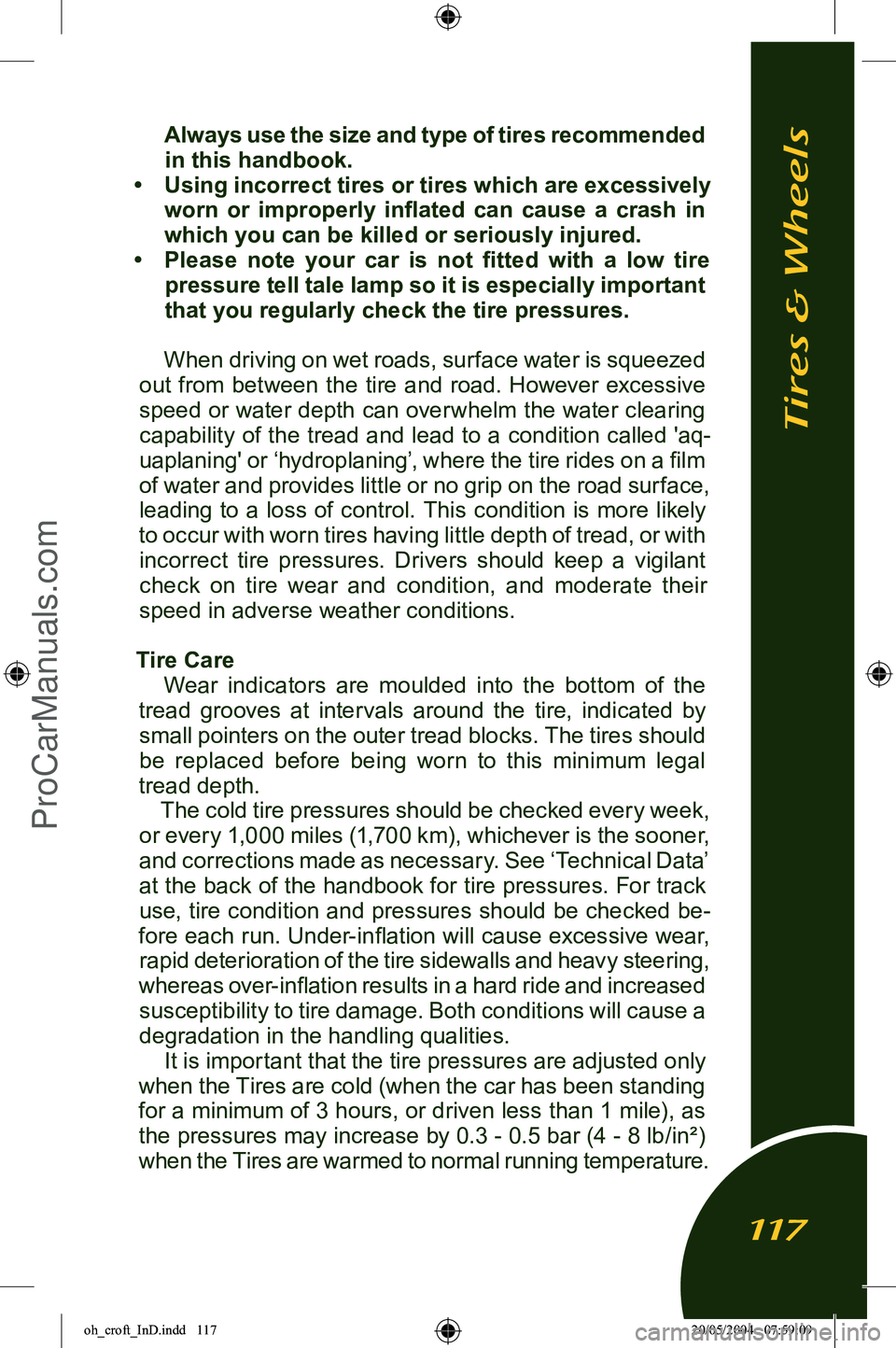
Always use the size and type of tires recommended
in this handbook.
• Using incorrect tires or tires which are excessively worn or improperly inflated can cause a crash in
which you can be killed or seriously injured.
• Please note your car is not fitted with a low tire pressure tell tale lamp so it is especially important
that you regularly check the tire pressures.
When driving on wet roads, surface water is squeezed
out from between the tire and road. However excessive
speed or water depth can overwhelm the water clearing capability of the tread and lead to a condition called 'aq
-
uaplaning' or ‘hydroplaning’, where the tire rides on a film of water and provides little or no grip on the road surface,
leading to a loss of control. This condition is more likely
to occur with worn tires having little depth of tread, or with incorrect tire pressures. Drivers should keep a vigilant check on tire wear and condition, and moderate their
speed in adverse weather conditions.
Tire Care Wear indicators are moulded into the bottom of the
tread grooves at intervals around the tire, indicated by small pointers on the outer tread blocks. The tires should
be replaced before being worn to this minimum legal
tread depth. The cold tire pressures should be checked every week,
or every 1,000 miles (1,700 km), whichever is the sooner,
and corrections made as necessary. See ‘Technical Data’
at the back of the handbook for tire pressures. For track
use, tire condition and pressures should be checked be
-
fore each run. Under-inflation will cause excessive wear, rapid deterioration of the tire sidewalls and heavy steering,
whereas over-inflation results in a hard ride and increased susceptibility to tire damage. Both conditions will cause a degradation in the handling qualities. It is important that the tire pressures are adjusted only
when the Tires are cold (when the car has been standing for a minimum of 3 hours, or driven less than 1 mile), as the pressures may increase by 0.3 - 0.5 bar (4 - 8 lb/in²)
when the Tires are warmed to normal running temperature.
Tires & Wheels
117
oh_croft_InD.indd 11720/05/2004 07:59:09ProCarManuals.com
Page 120 of 205

Use a good quality proprietary tire pressure gauge and always replace the tire valve dust cap to prevent the
ingress of dirt and moisture into the valve, which could cause leakage. Many fuel filling stations provide tire inflation facilities,
which specific usage instructions should be carefully fol
-
lowed. For tire pressure information, refer to ‘Technical
Data’ or the Certification Label on the driver’s door jamb
(see page 121).
Replacement Tires When replacing tires, refer to the ‘Technical Data’ sec
-
tion in this handbook, or consult your dealer to check the current Lotus specification and recommendations. Do not
use tires which differ from these specifications.
WARNING: Note that some tread patterns are directional, so
that the tire must be fitted onto the wheel with regard
to which side of the car the wheel is to be used. In
these cases, a direction of rotation arrow is included in the tire sidewall markings.
When balancing the wheel and tire assemblies, the
wheels should be located by the centre spigot hole - NOT by the wheel bolt holes. In order to maintain the correct
ohs115b
Direction of rotation arrow
Tires & Wheels
118
oh_croft_InD.indd 11820/05/2004 07:59:10ProCarManuals.com
Page 121 of 205
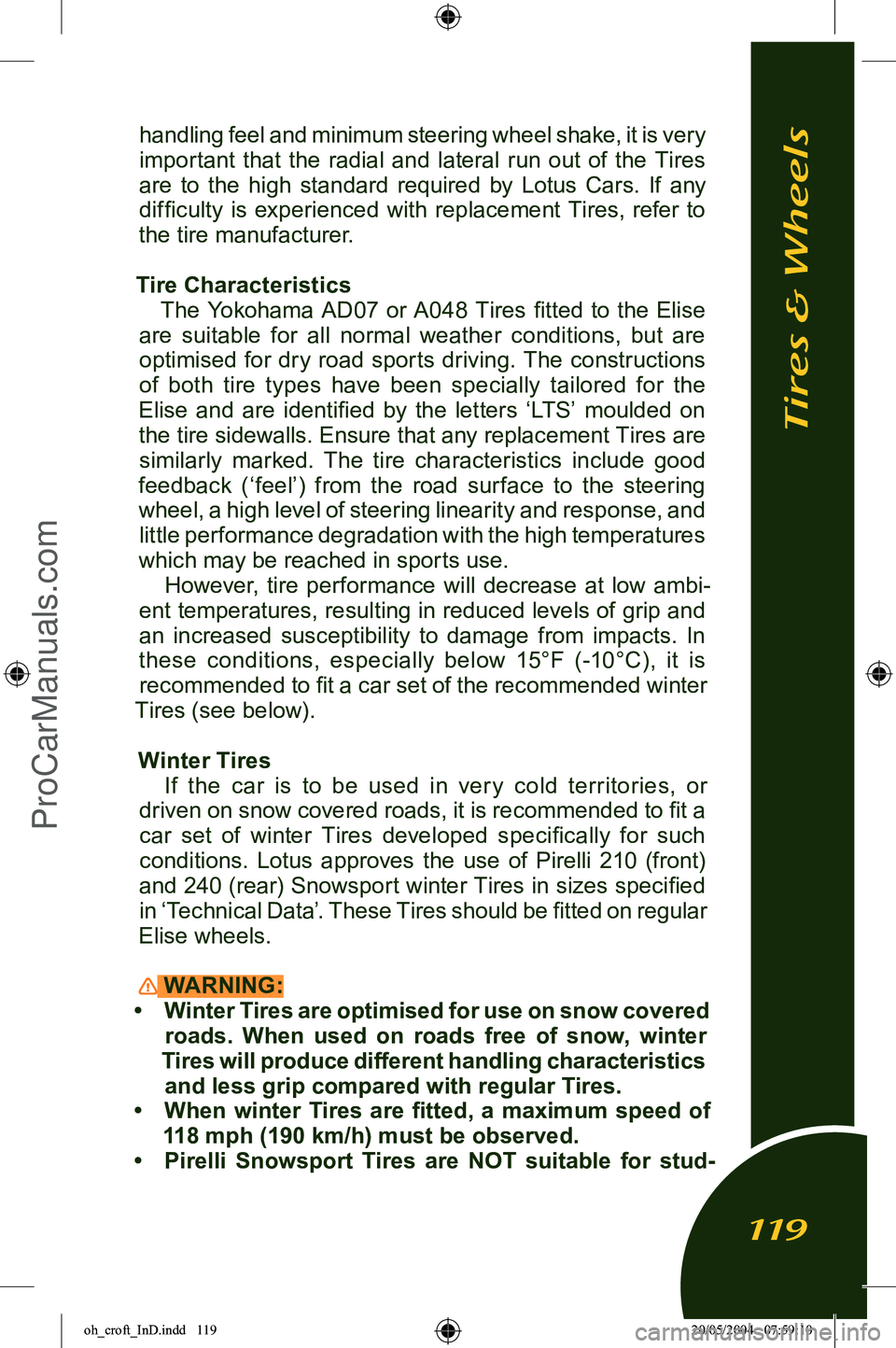
handling feel and minimum steering wheel shake, it is very
important that the radial and lateral run out of the Tires are to the high standard required by Lotus Cars. If any difficulty is experienced with replacement Tires, refer to
the tire manufacturer.
Tire Characteristics The Yokohama AD07 or A048 Tires fitted to the Elise
are suitable for all normal weather conditions, but are optimised for dry road sports driving. The constructions
of both tire types have been specially tailored for the
Elise and are identified by the letters ‘LTS’ moulded on the tire sidewalls. Ensure that any replacement Tires are similarly marked. The tire characteristics include good
feedback (‘feel’) from the road surface to the steering
wheel, a high level of steering linearity and response, and little performance degradation with the high temperatures
which may be reached in sports use. However, tire performance will decrease at low ambi
-
ent temperatures, resulting in reduced levels of grip and
an increased susceptibility to damage from impacts. In
these conditions, especially below 15°F (-10°C), it is recommended to fit a car set of the recommended winter
Tires (see below).
Winter Tires If the car is to be used in ver y cold territories, or
driven on snow covered roads, it is recommended to fit a
car set of winter Tires developed specifically for such
conditions. Lotus approves the use of Pirelli 210 (front)
and 240 (rear) Snowsport winter Tires in sizes specified
in ‘Technical Data’. These Tires should be fitted on regular
Elise wheels.
WARNING:
• Winter Tires are optimised for use on snow covered roads. When used on roads free of snow, winter
Tires will produce different handling characteristics and less grip compared with regular Tires.
• When winter Tires are fitted, a maximum speed of 118 mph (190 km/h) must be observed.
• Pirelli Snowsport Tires are NOT suitable for stud
-
Tires & Wheels
119
oh_croft_InD.indd 11920/05/2004 07:59:10ProCarManuals.com
Page 157 of 205
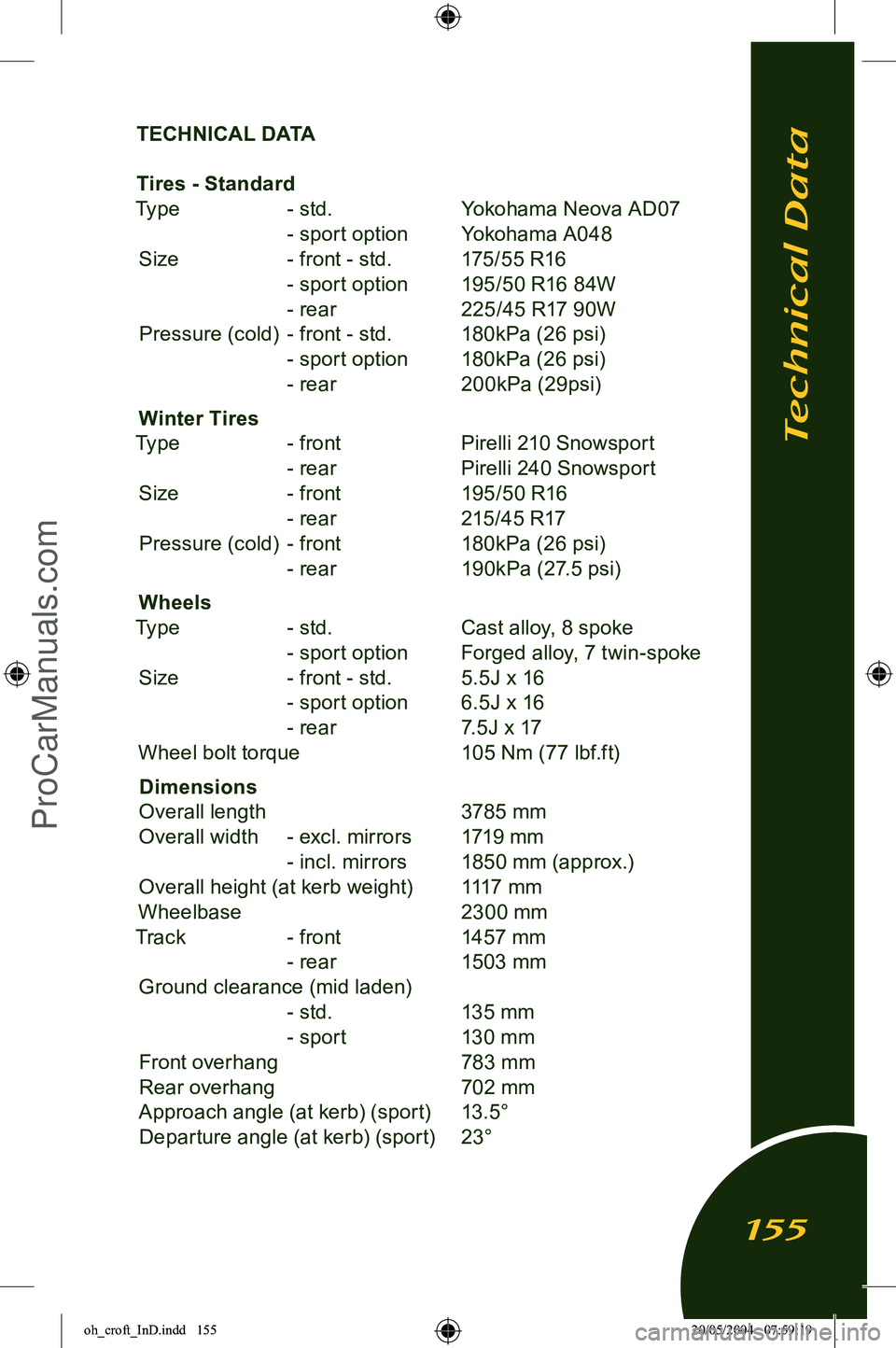
TECHNICAL DATA
Tires - Standard
Type - std. Yokohama Neova AD07
- sport option Yokohama A048
Size - front - std. 175/55 R16
- sport option 195/50 R16 84W
- rear 225/45 R17 90W
Pressure (cold) - front - std. 180kPa (26 psi)
- sport option 180kPa (26 psi)
- rear 200kPa (29psi)
Winter Tires
Type - front Pirelli 210 Snowsport
- rear Pirelli 240 Snowsport
Size - front 195/50 R16
- rear 215/45 R17
Pressure (cold) - front 180kPa (26 psi)
- rear 190kPa (27.5 psi)
Wheels
Type - std. Cast alloy, 8 spoke
- sport option Forged alloy, 7 twin-spoke
Size - front - std. 5.5J x 16
- sport option 6.5J x 16
- rear 7.5J x 17
Wheel bolt torque 105 Nm (77 lbf.ft)
Dimensions
Overall length 3785 mm
Overall width - excl. mirrors 1719 mm
- incl. mirrors 1850 mm (approx.)
Overall height (at kerb weight) 1117 mm
Wheelbase 2300 mm
Track - front 1457 mm
- rear 1503 mm
Ground clearance (mid laden)
- std. 135 mm
- sport 130 mm
Front overhang 783 mm
Rear overhang 702 mm
Approach angle (at kerb) (sport) 13.5° Departure angle (at kerb) (sport) 23°
Technical Data
155
oh_croft_InD.indd 15520/05/2004 07:59:19ProCarManuals.com
Page 158 of 205

Unladen weight - total 912 kg ) inc.
(heaviest) - front 344 kg ) full fuel
- rear 568 kg ) tank
Max. weight - total 1162 kg > incl.
- front 441 kg > occupants
- rear 721 kg > & luggage
Trailer towing Not permissible
Capacities Engine oil (refill inc. filter) 4.7 U.S. qt. (4.4 litre)
(+3.7 U.S. qt (3.5) litre if front mounted oil coolers are drained) High/low dipstick mark difference 1.6 U.S. qt. (1.5 litre)
Transmission oil 2.4 U.S. qt. (2.3 litre)
Fuel tank 10.6 U.S. gall. (40 litre)
Cooling system 12.7 U.S. qt. (12 litre)
A.C. refrigerant (R134a) 1.2 lb (0.55 kg)
Front Suspension
T ype Independent. Upper and
lower wishbone co-axial
coil spring/telescopic
damper unit; anti-roll bar
Steering axis inclination 12° nominal
Geometry specification - Standard: Mid-laden ride height (reference height for geometry check)
- front 135 mm below front end
of chassis siderail
- rear 135 mm below rear end
of chassis siderail
Castor - optimum + 3.8°
- tolerance range + 3.5° to + 4.1°;
max. side/side 0.35°
Camber - optimum - 0.1°
- tolerance range + 0.1° to - 0.3°
max. side/side 0.2°
Alignment - optimum Zero - tolerance range 0.5 mm toe-out, to
0.7mm toe-in overall
Technical Data
156
oh_croft_InD.indd 15620/05/2004 07:59:19ProCarManuals.com
Page 159 of 205
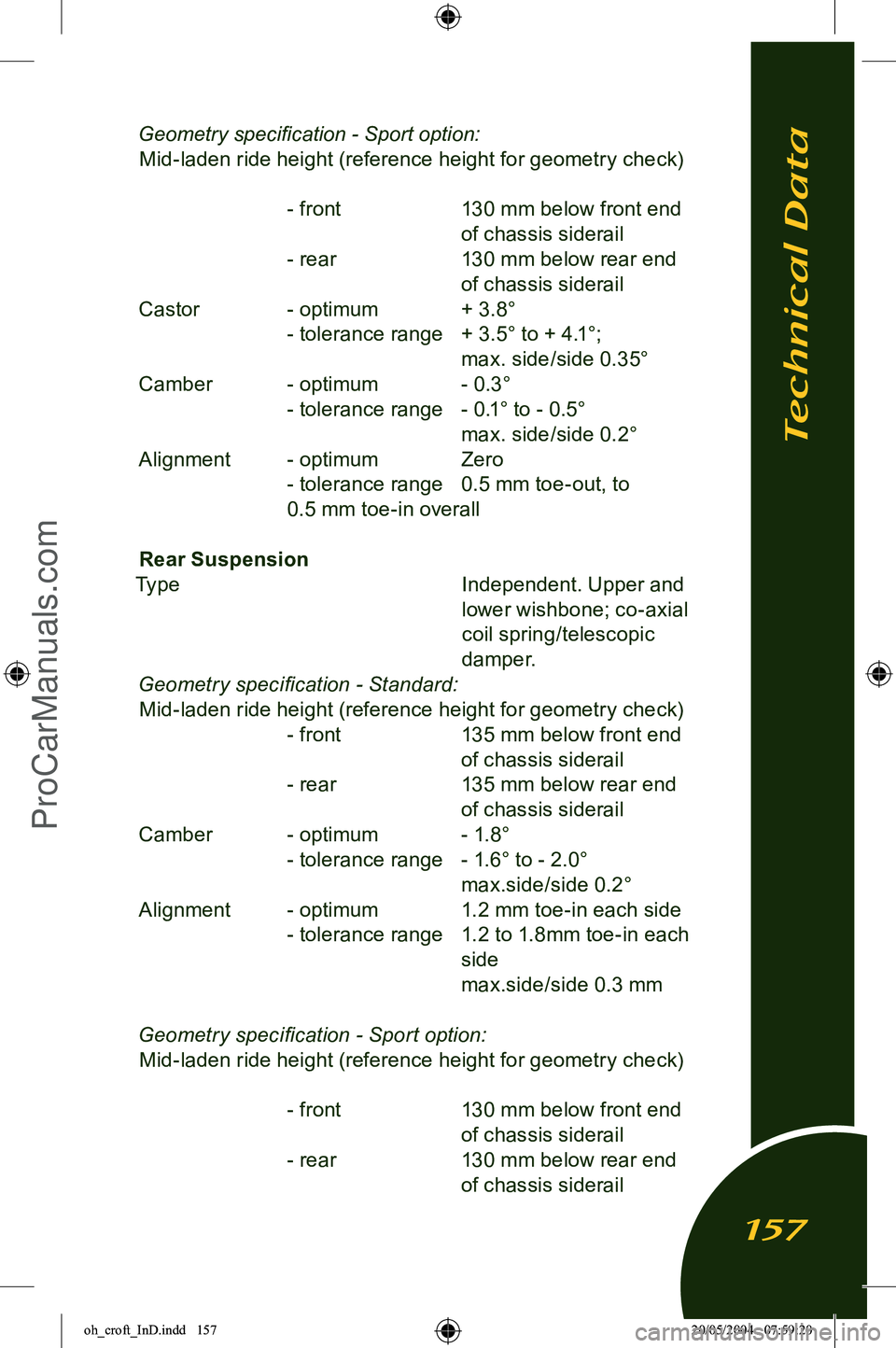
Geometry specification - Sport option:Mid-laden ride height (reference height for geometry check)
- front 130 mm below front end
of chassis siderail
- rear 130 mm below rear end
of chassis siderail
Castor - optimum + 3.8°
- tolerance range + 3.5° to + 4.1°;
max. side/side 0.35°
Camber - optimum - 0.3°
- tolerance range - 0.1° to - 0.5°
max. side/side 0.2°
Alignment - optimum Zero - tolerance range 0.5 mm toe-out, to
0.5 mm toe-in overall
Rear Suspension
Type Independent. Upper and
lower wishbone; co-axial
coil spring/telescopic
damper.
Geometry specification - Standard: Mid-laden ride height (reference height for geometry check)
- front 135 mm below front end
of chassis siderail
- rear 135 mm below rear end
of chassis siderail
Camber - optimum - 1.8°
- tolerance range - 1.6° to - 2.0°
max.side/side 0.2°
Alignment - optimum 1.2 mm toe-in each side - tolerance range 1.2 to 1.8mm toe-in each
side
max.side/side 0.3 mm
Geometry specification - Sport option: Mid-laden ride height (reference height for geometry check)
- front 130 mm below front end
of chassis siderail
- rear 130 mm below rear end
of chassis siderail
Technical Data
157
oh_croft_InD.indd 15720/05/2004 07:59:20ProCarManuals.com
Page 160 of 205
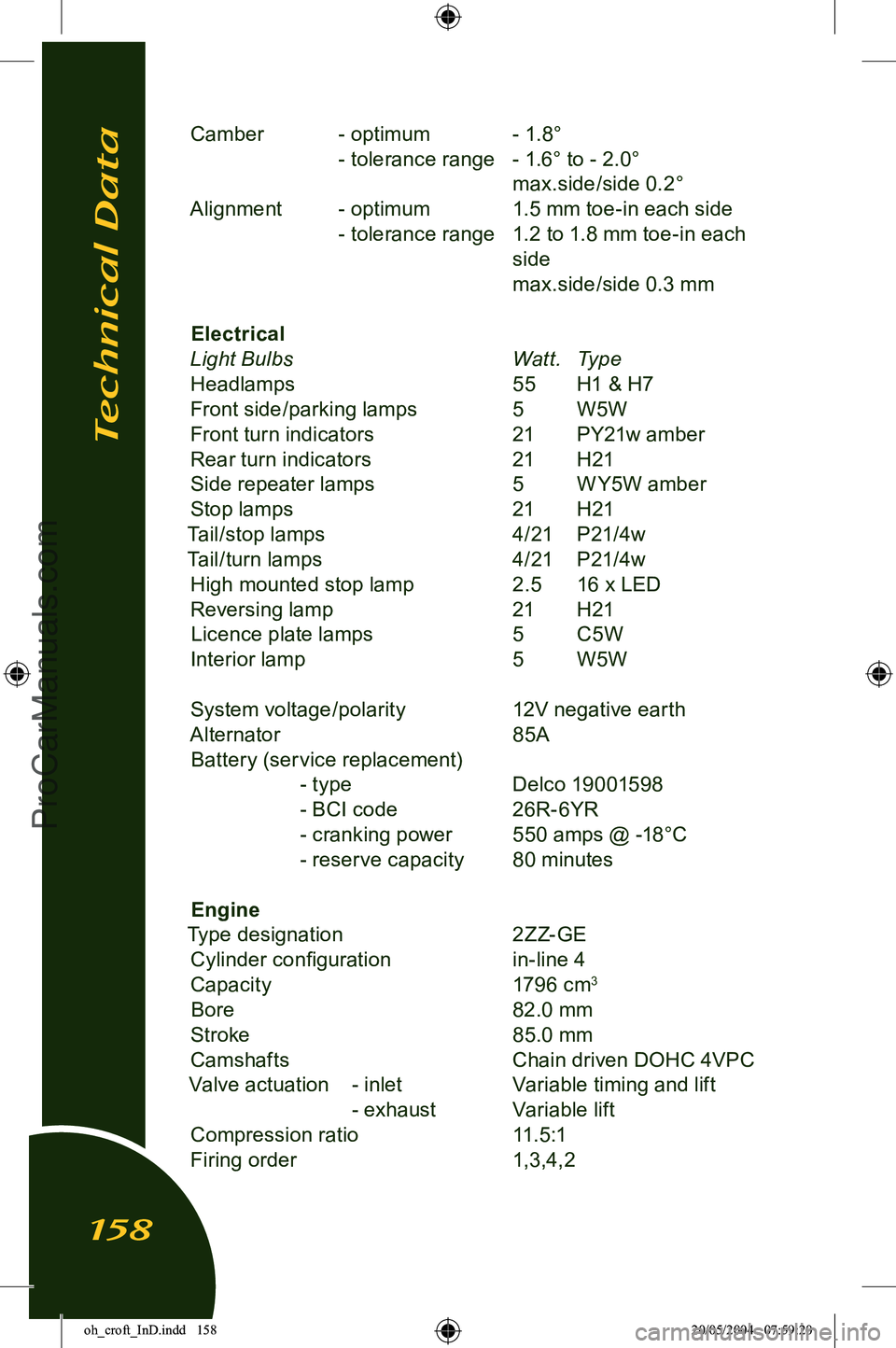
Camber - optimum - 1.8°
- tolerance range - 1.6° to - 2.0°
max.side/side 0.2°
Alignment - optimum 1.5 mm toe-in each side - tolerance range 1.2 to 1.8 mm toe-in each
side
max.side/side 0.3 mm
Electrical
Light Bulbs Watt. Type
Headlamps 55 H1 & H7
Front side/parking lamps 5 W5W
Front turn indicators 21 PY21w amber
Rear turn indicators 21 H21
Side repeater lamps 5 W Y5W amber
Stop lamps 21 H21
Tail/stop lamps 4/21 P21/4w
Tail/turn lamps 4/21 P21/4w
High mounted stop lamp 2.5 16 x LED
Reversing lamp 21 H21
Licence plate lamps 5 C5W
Interior lamp 5 W5W
System voltage/polarity 12V negative earth
Alternator 85A
Battery (service replacement)
- type Delco 19001598
- BCI code 26R- 6YR
- cranking power 550 amps @ -18°C
- reserve capacity 80 minutes
Engine
Type designation 2ZZ-GE
Cylinder configuration in-line 4
Capacity 1796 cm
3
Bore 82.0 mm
Stroke 85.0 mm
Camshafts Chain driven DOHC 4VPC
Valve actuation - inlet Variable timing and lift
- exhaust Variable lift
Compression ratio 11.5:1
Firing order 1,3,4,2
Technical Data
158
oh_croft_InD.indd 15820/05/2004 07:59:20ProCarManuals.com